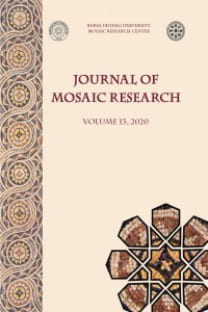Antakya Magdouh Mozaiği’nin Üçüncü Boyutu
Bu çalışma, Antakya’da bulunan, beşinci ve altıncı yüzyıllara ait Magdouh Mozaiğinin karmaşık geometrik düzeninin üç boyutlu içeriğini araştırmaktadır. Bunun nedeni, mozaik kompozisyonunu oluşturan geometrik düzenin yüzeyde oldukça güçlü bir derinlik etkisi oluşturmasıdır. Bu amaçla çalışma kapsamında bu mozaiğin geometrik dokusunu oluşturan elemanlar ile bunların arasındaki ilişkilerin üçüncü boyuttaki geometrik karşılıkları belirlenmeye çalışılmıştır. Bu kapsamda öncelikle mozaik bütününe bakıldığında görsel kompozisyon düzlemsel olarak dört katmandan oluşan daire kümelerinden oluşan kare tabanlı tepeler olarak görülmektedir. Bu tepelerde simetrik olarak dört farklı doğrultuda birbirine teğet olan, birbirleri üstüne binen ve birbirleri ile kesişen daireler bir arada görülmektedir. Üçüncü boyuta taşındığında da bu kümelerin dokusunu oluşturan dairelerin, dik koordinat sisteminde birbirleriyle kesişen kürelere karşılık geldiği belirlenmiştir. Kürelerin dik koordinat sisteminde bu oranda kesişmesi ile oluşan üç boyutlu ağ içerisinde her bir küre, bir küp sekizyüzlünün kenarlarını oluşturacak şekilde paketlenen sekiz adet düzgün dörtyüzlü bir küme içerirken, kesişen herhangi iki kürenin kesişen yarıları ise yıldızlaşmış bir düzgün sekizyüzlü içermektedir. Her bir yıldızlaşmış sekizyüzlü ise birbirleriyle kesişen dört adet rombik altı yüzlü birime ayrıştırılabilmektedir. Bu gometrik içerik bir bütün olarak değerlendirildiğinde, Magdouh Mozaik yüzeyi üçüncü boyutta uzayı boşluksuz doldurabilen eş altı yüzlü birimlerin paketlenmesi olarak karşılık bulmaktadır.
The Third Dimension of the Magdouh Mosaic in Antioch
This study investigates the complex geometry of the pattern of circles in the Magdouh Mosaic, which dates to between the ffth and sixth centuries, found in Antioch-on-the-Orontes (modern Antakya, Turkey). The mosaic has a complex pattern that is composed of tangent, overlapping and intersecting circles suggesting that it was worthwhile analyzing in 3D. Through such an analysis, it was observed that the extension of the pattern of circles into a third dimension looks like spheres packed together that intersect in three directions at right angles. This can also be demonstrated by packing octahemioctahedra, which are a cluster of eight regular packed tetrahedra contained within the spheres. In addition, the packing of octahemioctahedra in this way also suggests the packing of stella octangula contained within hemispheres that intersect each other. Furthermore, tracing the line segments that are emphasized in each circle in the Magdouh Mosaic in such a 3D structure turns them into space-flling rhombohedra that can be dissected into two tetrahedra and an octahedron. Thus, the result of this study shows that the Magdouh Mosaic in Antioch is the top view of a square-based pyramidalcluster of intersecting hemispheres that hold space-flling rhombohedra inside them.
___
- al-Muheisen - Nassar 2014 Z. al-Muheisen - M. Nassar. “Geometric Mosaic Pavements at Ras ed-Deir, Jordan”, GrRomByzSt 54, 1, 87– 104.
- Balderstone 2009 S. Balderstone, “A New View of the Pella Churches in Terms of Dating and Analysis: The Typological Context”, Levant 41, 1, 93-106.
- Barsanti 2012 C. Barsanti, “The Fate of the Antioch Mosaic Pavements: Some Refections”, JMR 5, 25-42.
- Becker - Kondoleon 2005 L. Becker - C. Kondoleon, The Arts of Antioch: Art Historical and Scientifc Approaches to Roman Mosaics and a Catalogue of the Worcester Art Museum Antioch Collection, Worcester Art Museum, Worcester, MA.
- Biebel 1938 F. M. Biebel, “Mosaics”, C.H. Kraeling (ed.), Gerasa, City of the Decapolis, American Schools of Oriental Research, New Haven (CT), 297-352.
- Blakemore 1985 J. S. Blakemore, Solid State Physics, Cambridge. Campbell 1988 S. Campbell, The Mosaics of Antioch, Pontifcal Institute of Mediaeval Studies, Toronto.
- Cimok 2000 F. Cimok, Antioch Mosaics, İstanbul. Concise Dictionary of Mathematics 2013
- Concise Dictionary of Mathematics, New Delhi.
- Dunbabin 1989 K. M. D. Dunbabin, “Roman and Byzantine Mosaics in the Eastern Mediterranean”, JRA 2, 313-318.
- Elderkin 1934 G. W. Elderkin, Antioch on the Orontes I: The Excavations of 1932, Princeton.
- Hachlili 1998 R. Hachlili, Ancient Jewish Art and Archeology in the Diaspora, Leiden, Boston, Köln.
- Haynes 1951 I. E. Haynes, “Antioch Mosaic Pavements by Doro Levi”, Antiquity 25, 98, 111-112.
- Hopkins 1948 C. Hopkins, “Antioch Mosaic Pavements”, JNES 7, 2, 91-97.
- Kappraff 2002 J. Kappraff, Connections: The Geometric Bridge Between Art and Science 2nd Edition, World Scientifc, Singapore.
- Kondoleon 2000 C. Kondoleon, “Mosaics of Antioch”, C. Kondoleon (ed.), Antioch: The Lost Ancient City, Princeton, 63–77.
- Levi 1947 D. Levi, Antioch Mosaic Pavements, Princeton. Nassar 2010 M. Nassar, “Geometric Mosaic Pavements of Yasileh in Jordan”, PEQ 142, 3, 182–198.
- Nassar - Sabbagh 2016 M. Nassar - A. Sabbagh, “The Geometric Mosaics at Khirbat Mar Elyas: A Comparative Study”, GrRomByzSt 56, 3, 528–555.
- Parzysz 2009 B. Parzysz, “Using Key Diagrams to Design and Construct Roman Geometric Mosaics?”, NNJ 11, 2, 273-288.
- Stillwell 1938 R. Stillwell, Antioch on the Orontes II: The Excavations of 1933-1936, Princeton.
- Stillwell 1941 R. Stillwell, Antioch on the Orontes III: The Excavations of 1937-1939, Princeton.
- Williams 1979 R. Williams, The Geometrical Foundation of Natural Structure a Source Book of Design, New York.
- ISSN: 1309-047X
- Başlangıç: 2008
- Yayıncı: Ululdağ Üniversitesi, Mozaik Araştırlmaları Merkezi
Sayıdaki Diğer Makaleler
Antakya Magdouh Mozaiği’nin Üçüncü Boyutu
Beyhan BOLOK HİSARLIGİL, Hakan HİSARLIGİL
Etkileşim Kompozisyonu Üzerine Bazı Düşünceler - Yüzey
Mozaikler Üzerinde Betimlenen Deniz Taşıtlarının İkonografsi ve Deniz Arkeolojisi Açısından Önemi
Marcelo MENDES PINTO, Fátima ABRAÇOS, Licínia WRENCH
Miguel PESSOA, lsa SIMOES, Sonia VICENTE, Ana Luisa Ravara MENDES
Latium’un Güney Kıyılarındaki Cumhuriyet ve İmparatorluk Dönemi Mozaikleri. Nicel Bir Analiz
Türkmenistan, Gonur Depe, Tunç Çağı Nekropol Mozaikleri
Galina E. VERESOTSKAYA, Nadezhda A. DUBOVA, Anatolij M. YUMINOV, Natalia A. KOVALEVA
